

|
AudioAmp click Released

AudioAmp click is a mikroBUS add-on board that functions as a mono audio amplifier. It is driven by a Texas Instruments LM48100Q-Q1 Boomer Mono, 1.3W Audio Power Amplifier IC.
AudioAmp click has one 3.5 mm input jack and next to it screw terminals for connecting output wires to a passive speaker. It has dual audio inputs that can be mixed/multiplexed to the device output. Each input path has its own independent, 32-step volume control. The mixer, volume control and device mode selection are controlled through the mikroBUS I2C interface.
Fault detection is another important feature of LM48100Q. It senses the load conditions, protecting the device during short circuit events, as well as detecting open circuit conditions.
AudioAmp click can work either on a 3.3V or a 5V power supply. There's an additional jumper for selecting the I2C address as well. The open-drain output fault flag. FAULT is routed through the default mikroBUS INT pin (0 indicates that a fault condition has occurred).
|
2016/07/27 |


|
Thumbwheel Click Released

Thumbwheel click is a mikroBUS add-on board with a 10-position rotary sprocket connected to a 1-Wire 8-Channel Addressable Switch. The starting position of the switch is marked with a small notch on the PCB above the wheel. Printed numerals from 1 to 10 clearly mark each position.
The thumbwheel has a crown with small incisions for better finger traction. The board can use both a 3.3V or a 5V power supply. The One-Wire signal can be sent either through the mikroBUS AN or PWM pins. You choose which one by soldering the GP SEL jumper into the right position.
|
2016/07/27 |

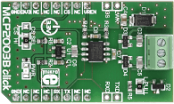
|
MCP2003B click (LIN) Released

MCP2003B click is a mikroBUS add-on board with a bi-directional LIN transceiver.
It's a physical interface to automotive and industrial LIN systems, in accordance to the LIN Bus Specifications Revision 2.2, SAE J2602 and ISO 17987. This standard requires that all nodes in the system are to be connected through a LIN bus. Up to 15 slave devices can be connected to a single master.
The click has three onboard screw terminals for connecting the transceiver to a LIN network (three wires: LIN, VBB and GND).
MCP2003B click communicates with the target board MCU through the mikroBUS UART interface (RXD, TXD), with additional functionality provided by the VRENDIV and LWAKE pins. Extra pins for LWAKE, CS, and TX and RX are also available above the mikroBUS.
The board is designed to use a 3.3V power supply only.
|
2016/07/27 |


|
Force click Released

Force click is a mikroBUS add-on board with circuitry for implementing Interlink Electronics Force Sensing Resistors into your projects (with a single zone force sensing resistor included with the click).
The Force Sensing Resistor is a thin sensor made of two membranes that are separated by a spacer around the edges. When pressed, the gap between two membranes gets closed. This shorts the two membranes together, with a resistance that is proportional to applied force. The outputted analog voltage is thus a measure of force applied.
The force sensitivity range is from about 0.2N to 20N (although it depends on the implementation). Force click communicates with the target MCU through the mikroBUS AN pin. It is designed to use either a 3.3V or 5V power supply.
|
2016/07/27 |


|
MCP25625 click (CAN) Released

MCP25625 click is a mikroBUS add-on board carrying a Microchip CAN controller with an integrated transceiver. It meets the automotive requirement for high speed operation (up to 1 Mb/s).
Named after the main chip, MCP25625 click also has a RS232 port, which is a standard connector for CAN communications. Additionally, the two CAN wires (CANL and CANH) can also be connected directly through two pins on the right edge of the board.
The click communicates with the target MCU through the SPI interface - although there are additional options that take the load off the target board MCU. To that end, all 16 mikroBUS pins are connected. There's a clock output, a Request To Send, an Interrupt, standby, reset and more. MCP25625 click can work with both 3.3V or 5V logic levels.
|
2016/07/27 |

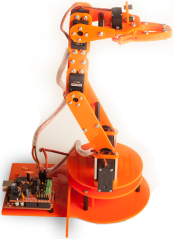
|
Eduardo 5-Axis Robotic Arm Kit Released

The Eduardo robotic arm is an educational platform for teaching and learning robotics and micro-electronics. The kit is supplied disassembled, so part of the education involves assembly of the arm. The arm has 5 joints, powered by 6 servo motors, driven by an Arduino with motor shield.
Please note that pricing is approximate and may be subject to MOQ.
|
2016/07/13 |

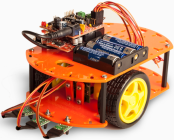
|
Eduardo Robotic Car Kit Released

The Eduardo two-wheeled robotic car is an educational platform for teaching and learning robotics and micro-electronics. The kit is supplied disassembled, so part of the education involves assembly of the vehicle. The kit features a chassis, independent DC motors for the left and right wheels, optical slotted disc sensors for detecting movement on each of the wheels, analogue infrared sensors for line-following, battery holder and an Arduino with motor shield to drive everything.
Please note that pricing is approximate and may be subject to MOQ.
|
2016/07/13 |


|
Ozone click Released

Ozone click is a mikroBUS add-on board with a MiCS-2614 compact MOS sensor for ozone (O3) detection. Its detection range is from 10-1000ppb. It's a small(5 x 7 x 1.55mm) MEMS sensor consisting of a micro machined diaphragm with an embedded heating resistor and the sensing layer on top.
The sensor outputs an analog voltage, which is converted by the onboard MCP3201 12-bit ADC converter.
Ozone click communicates with the target MCU through the mikroBUS SPI interface (CS, SCK, MISO). The board is designed to use a 5V power supply only.
|
2016/07/12 |


|
IR Beacon click Released

IR Beacon click is a mikroBUS add-on board with an array of nine high speed infrared emitting diodes. It functions as a beacon device, transmitting infrared rays in a wide angle, which can be detected by nearby infrared receivers (such as the one on IR click). Each of the nine VSMB2948SL diodes have a transparent plastic package that serve as tiny lenses.
The IR wave has a half intensity angle of ± 25 degrees. The diodes have high radiant power and intensity with a peak wavelengths of 940nm.
IR Beacon click is suitable for high pulse current operation. The mainboard MCU drives the infrared diodes through the mikroBUS MOD pin, providing a carrier signal (which can be modified to match the frequency of the receiver). Either UART or PWM can be used to transmit a signal to a target receiver (specified by the position of the TX SEL jumper is in the middle of the board).
The range is up to half a meter. You can increase it by stacking multiple IR Beacon clicks onto a same mikroBUS socket.
The board can use either a 3.3V or a 5V power supply.
|
2016/07/12 |


|
Matrix click Released

Matrix click is a mikroBUS add-on board with two 5x7 matrices driven by two MAX7219 8-bit LED Display Drivers. The active area of each matrix is 7.62mm high and 5.08 mm wide. 7x5 is a standard resolution for displaying ASCII characters, so the click is essentially a dual-character display capable of showing letters in more readable typefaces compared to a 14-segment display. The click communicates with the target MCU through the mikroBUS SPI interface with two separate Chip Select lines for each matrix (CSL for the left, CSR for the right). This board is designed to use a 5V power supply.
|
2016/07/12 |

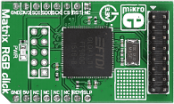
|
Matrix RGB click Released

Matrix RGB click is a mikroBUS add-on board powered by a 32-bit FT900 MCU designed specifically for powering 16x32 RGB LED matrices.
The board has a 16 wire IDC connector for connecting to a single 16x32 LED panel, however, the firmware inside the FT900x chip can drive more than one panel.
Multiple panels can be connected to each other into a daisy-chain configuration (see the video). Matrix RGB click communicates with the target MCU through the SPI interface. It uses a 3.3V power supply only.
Complete kits with Matrix RGB click, a single 32x32 RGB LED matrix panel (consisting of two 16x32 matrices joined together), and a power supply unit are available to order.
Alternatively, panels and power supplies can be purchased separately.
|
2016/07/12 |

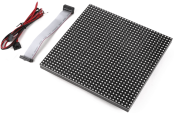
|
32x32 RGB LED Matrix Panel Released

Hi-brightness RGB LED matrix panel, with 1024 RGB LEDs arranged in a 32x32 grid on the front. Comes with one IDC cable and a power cable.
The panel is driven by shift registers, for more information please see the Learn Article.
|
2016/07/12 |


|
Matrix RGB Panel Kit Released

Complete development kit for RBG LED matrix which includes Matrix RGB click, a single 32x32 RGB LED matrix panel (consisting of two 16x32 matrices joined together) and a 5V/3A power supply unit.
|
2016/07/12 |

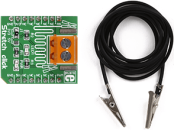
|
Stretch click Released

Stretch click is a mikroBUS add-on board with circuitry for measuring stretch forces with conductive rubber cords. The click has screw terminals for connecting 2mm-diameter conductive rubber cord. The resistance of the chord increases when stretched, impacting the voltage available on the AN pin. Stretch click is designed to use either a 3.3V or 5V power supply.
In a "relaxed" state, the resistance is about 130 ohms per centimeter. As you pull on it, the resistance increases (the particles get further apart). As you stretch it out, the resistance increases. So lets say you have a 15cm piece - thats about 2.1 Kohms.
Stretch it to 25cm long and now it is 26/15*2.1K = 3.5 Kohms. You can stretch the rubber about 50-70% longer than the resting length, so a 15cm piece shouldn't be stretched more than 25cm. Once the force is released, the rubber will shrink back, although its not very "fast" and it takes a minute or two to revert to its original length. It's not a true linear sensor, and the resistance may vary from batch to batch, so we consider it a way to measure stretching motion but isn't really precise.
One meter of conductive rubber cord and two alligator clips are included in the package.
|
2016/07/12 |


|
Compass 2 click (Magnetometer) Released

Compass 2 click is a mikroBUS add-on board with an AK8963 3-axis electronic compass. The high sensitivity sensor is based on the Hall effect. The built-in ADC converter can be set up at either 14 or 16 bit resolution, for each of the 3 axes. The sensitivity is 0.6µT /LSB typ. at 14-bit, and 0.15µT/LSB at 16-bit. Compass 2 click communicates with the target MCU through either through the I2C or SPI interface, with an added INT pin. Onboard jumpers enable you to switch between two interfaces. The board is designed to use a 3.3 power supply only.
|
2016/07/12 |

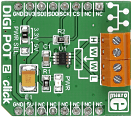
|
Digital Pot 2 click Released

DIGI POT 2 click is a mikroBUS add-on board with a single channel digital potentiometer TPL0501 with 256 wiper positions. The IC has 100 kilo Ohms end-to-end resistance, with ± 20% tolerance. The board features two pairs of screw terminals for interfacing with the IC DIGI POT 2 click communicates with the target MCU through the mikroBUS SPI pins (MISO, MOSI, SCK, CS). The board is designed to use either a 3.3 or a 5V power supply.
|
2016/07/12 |

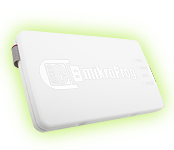
|
mikroProg for Kinetis Released

mikroProg for Kinetis is a fast programmer and hardware debugger for NXP's popular ARM Cortex-M4 Kinetis microcontrollers from the K22 and K64 families. Outstanding performance, easy operation, elegant design and low price are it's top features. mikroProg for Kinetis is fully supported in MikroElektronika ARM compilers (mikroC, mikroPascal and mikroBasic)
|
2016/07/12 |


|
clicker 2 for Kinetis Released

clicker 2 is a battery-powered click board two-seater. NXP's K64 family of microcontrollers are optimized for low power applications, while preserving impressive performance across key specifications such as run power consumption down to 250 µA /MHz, Static power consumption down to 5.8 µA with full state retention and 5 µS wakeup.
|
2016/07/12 |


|
Kinetis clicker Released

Kinetis clicker is an amazingly compact starter development kit which brings click board connectivity an NXP Kinetis microcontroller. Connect the desired click board to enhance it with additional features. It's preprogrammed with a fast USB HID bootloader. Use it to upload your firmware and the clicker will become a working device. The board features all you need to get started: a low power ARM Cortex-M4 32-bit MK22FN512VLH12 microcontroller, a USB connector, two LEDs and push buttons, reset button, mikroProg connector and headers for interfacing with external electronics.
|
2016/07/12 |

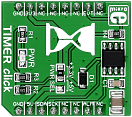
|
TIMER click Released

Timer click is a mikroBUS add-on board with Maxim's DS1682 total elapsed time recorder. The main feature of the IC is its elapsed time counter (ETC) used in conjunction with the ALARM pin. Whenever the EVENT pin is held high, the ETC will track time in quarter second resolution. Once the EVENT pin is set to logic low, the time data will be written in the IC's non volatile EEPROM. The next time the EVENT pin is pulled high, the timer will pick up where it left and continue measuring accumulated time. The upper limit is 34 years. In practical applications, the ALARM pin will be utilized to set off a flag once a certain threshold of accumulated time is reached. The alarm flag is one time programmable. The board communicates with the target MCU through the mikroBUS I2C interface, with two additional pins: ALARM (in place of default INT) and EVENT (in place of RST). Designed to use either a 3.3V or a 5V power supply.
|
2016/07/12 |

|

